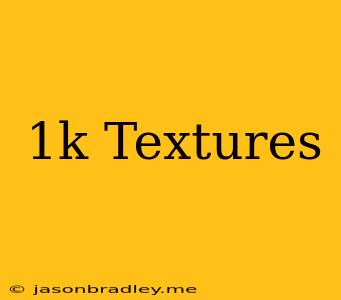1K Textures: A Beginner's Guide to Understanding and Using Them
In the world of 3D modeling and game development, textures are essential for adding visual detail and realism to objects. 1K textures, specifically, are a popular choice for many projects. But what exactly are they, and why are they so widely used?
What are 1K Textures?
The term "1K" refers to the resolution of a texture. In this case, a 1K texture has a resolution of 1024 pixels by 1024 pixels. This means that the texture file contains 1,048,576 individual pixels, each of which can be assigned a specific color and detail.
Why Use 1K Textures?
1K textures strike a balance between quality and performance. They offer a decent level of detail for most 3D models without significantly impacting rendering times or requiring excessive memory.
Here are some key benefits of using 1K textures:
- Good Detail: They provide enough resolution to showcase surface features, textures, and other visual elements, enhancing the realism of your models.
- Performance Optimization: 1K textures are relatively lightweight compared to higher-resolution options, allowing for smoother rendering in real-time applications.
- Wide Compatibility: They are widely supported by various 3D modeling and game development software, ensuring compatibility across different platforms.
When to Use 1K Textures
1K textures are suitable for a wide range of projects, including:
- Low-poly models: They can significantly improve the visual fidelity of simpler models without adding too much processing overhead.
- Game assets: They are a common choice for character models, environments, and props in games, particularly those targeting a wide range of devices.
- Concept art: 1K textures are useful for creating high-quality renderings and showcasing design ideas.
- Architectural visualizations: They can provide realistic detail for buildings, furniture, and other elements in architectural projects.
Considerations
While 1K textures offer a good balance, it's important to remember that they may not be suitable for every situation. Here are some factors to consider:
- Complexity of the Model: For highly detailed models or those with intricate textures, higher-resolution textures might be needed.
- Target Platform: The capabilities of the target platform, whether it's a mobile device, PC, or console, can influence the optimal texture resolution.
- Project Requirements: The specific needs of your project, such as rendering quality, performance, and file size constraints, should guide your texture resolution choice.
Conclusion
1K textures offer a good balance between detail and performance, making them a popular choice for many 3D modeling and game development projects. By understanding the advantages and limitations of this resolution, you can effectively use 1K textures to create high-quality visuals while maintaining optimal performance.
